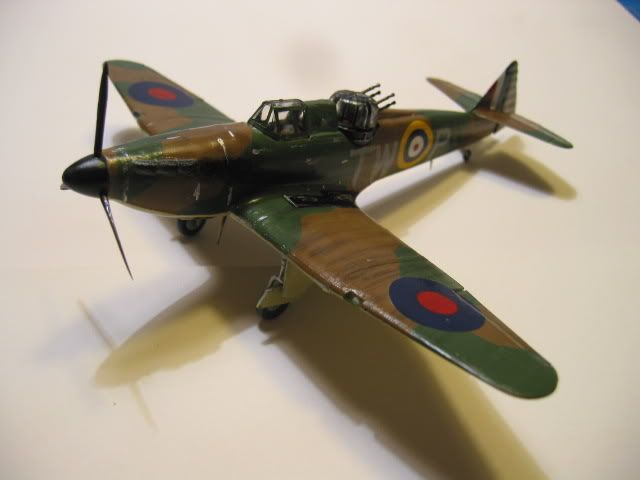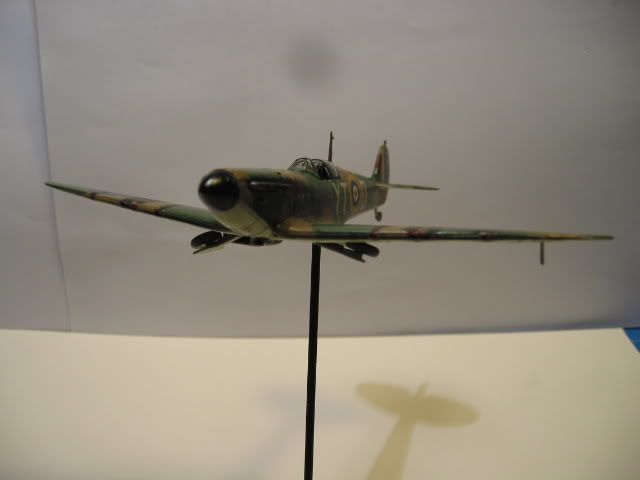Mobious – Great Emil!
GZT – lovely work so far on the Hurri
Karl – STU-pendous Stuka!
Clebode – very nice job on the Dornier, don’t see many of those
Apart from the 110 which is still on the bench, I'm calling "done" on my others in this great Group Build. Quick refresh - all are 1/72 by Airfix and built mostly OOB, brush painted with Revell Acrylics, with some minor added extras - Falcon Clearvax canopy and aftermarket decals (courtesy of Colin @ IPMS UK Decal Bank) on the Spitfire; Hasegawa decals, Falcon canopy and Revell figures on the 109. The Defiant was the biggest project, getting a new nose courtesy of a Revell Hurricane Mk1 but otherwise OOB. Have also added some brief biogs on each aircraft for those interested, courtesy of "The Most Dangerous Enemy" (by Stephen Bungay) & "Fighter Boys" (by Patrick Bishop).
First, the Bf109 in the markings I./JG 2 “Richtofen” flown by Major Helmut Wick.
At 1530 on 28 November 1940, Wick led his Stabschwarm back out over his favourite hunting ground over the Needles. Just after he had taken off, a signal arrived at Headquarters. Major Wick was to be grounded with immediate effect as he was too valuable a pilot to be risked in combat. That morning’s Berlin weekly newspaper featured a picture of a smiling Wick with Hermann Goering, Head of the Luftwaffe visiting his old unit, Richtofen Geschadwer.


South west of the Isle of Wight, Wick and his wingman, Rudi Pflanz met some Spitfires from 152 and 609 Squadrons climbing to meet them. Wick and his flight dived on them and Wick shot down Paul Ballion who had only just joined the Squadron. Wick followed it down to make sure of the kill. It was 1613 and he was now the top-scoring German ace with 56 kills. Just at that moment, over the R/T was heard the voice of John Dundas “I’ve finished a 109. Whoopee!”. “Good Show John” replied his Squadron Leader, Michael Robinson.

Rudi Pflanz saw Wick get hit and bail out. Just as his attacking Spitfire turned away, Pflanz got it in his sights and sent it into the Channel as well. No trace of either Wick or Dundas, or their planes were ever found.
Next, the Boulton Paul Defiant in the markings of 141 Squadron.
The Defiant was effectively the RAF’s version of a “Zerstorer” or heavy fighter and was designed, according to an Air Staff memo of 1938 for "the destruction of opposing fighters...for these purposes, it requires an armament that can be used defensively as well as offensively in order to enable it to penetrate into enemy territory and withdraw at will. The fixed-gun fighter cannot do this".

The concept seemed like a good idea, especially for shooting down bombers and Churchill briefly flirted with the idea that turret fighters were best. In 1938, the Deputy Chief of the Air Staff ordered nine squadrons to be formed, and 450 aircraft were ordered. Hugh Dowding, Commander in Chief of Fighter Command resisted and when the battle opened, only 2 squadrons were equipped with Defiants 141 and 264. It had no fixed forward armament and instead had an electrically powered turret armed with four Browning machine guns and a crew of two. Its top speed was just over 300mph.

On the morning of 19 July, Defiants of 141 Squadron were moved forward to Hawkinge. The crews of 141 had never been in combat before having only arrived in the South of England the previous week. At 12.30pm, 12 aircraft were ordered to patrol just shout of Folkestone – three remained behind with mechanical trouble. There was no warning from their controllers when 15 minutes later, 109’s from Richtofen Geschwader dived from the sun to attack. Four Defiants fell in the first pass. The gunners,clamped into their claustrophobic turrets went down with their aircraft. One pilot baled out and was rescued. A fifth Defiant was shot down minutes later – the gunner baled out and was wounded, the pilot was killed.

Four of the nine aircraft made it back to Hawkinge – of those, two were damaged and one was beyond repair. In the space of less than 15 minutes, the new squadron lost seven aircraft and 12 pilots and gunners. What was left of the squadron was sent back to Scotland two days later.

Defiants of 264 Squadron remained in the maelstrom that was the South East of England until 28th August, when 264 Squadron were bounced by 109s led by Adolf Galland of III Gruppe, JG26. Three were shot down in as many minutes, one crash landed and two limped home. The five remaining serviceable aircraft transferred out that day to 12 Group in Lincolnshire.
Finally, the Supermarine Spitfire in the markings of RAF 65 Squadron, flown by Brendan Finucane.


Born and raised in Ireland, Brendan Finucane DSO, DFC & Two Bars was better known as Paddy Finucane and joined the RAF in May 1938. After flying training and conversion to the Spitfire, he was posted as a Pilot Officer to 65 Squadron at RAF Hornchurch in 1940. Finucane claimed his first victory in the Battle of Britain on 12 August 1940, a Bf 109. No. 65 Squadron was rested at the end of August 1940 and did not return to 11 Group until November. Flying from RAF Tangmere, by year's end, Finucane had claimed four Bf 109s and a Bf 110.


Finucane became the youngest Wing Commander in the RAF on 27 June 1942, leading the Hornchurch Wing and was killed on 15 July 1942, when returning from a fighter sweep over France. His aircraft was hit in the radiator by ground fire and too low to bale out, he prepared for a landing in the Channel. Over the R/T before he hit the sea in a curtain of spray, his fellow pilots hear “This is it chaps”. Neither Finucane or his Spitfire were ever found. At the time of his death, he had claimed a total of 26 aircraft destroyed, six shared destroyed and eight probables. Brendan Finucane, survivor of the Battle of Britain, was aged 21.
Thanks to you all for your support on what's been a great GB and to Darson for organising!
Remembering the Few..
Best wishes,
Dermot